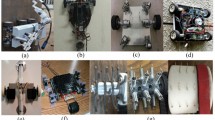Abstract
In this paper, we study the kinematic mechanism and path planning for a two-caster nonholonomic vehicle (the Essboard) which is a recent variant of skateboard. Different from the most studied Snakeboard, the Essboard consists of a torsion bar and two platforms, each of which contains a pedal and a caster. We first investigate the relationship between the tilt angles of the pedals and the wheel directions of the casters. This relationship reveals how to control the wheel directions by adjusting the tilt angles. Next, the rotational radius of the Essboard is derived for a given pair of tilt angles of both pedals. The rotational radius of the Essboard is much different than that of the Snakeboard. Then we develop a path-planning algorithm for the Essboard to move from a start position to the goal, using a series of consecutively connected arcs, which are tangent to each other at the connected points. It is shown from a kinematic point of view that the path planning of the Essboard can be solved by a series of pairs of pedals’ tilt angles. Three experiments are conducted to confirm the correctness of the main results. The results in this paper are a foundation for further study of the Essboard.
Similar content being viewed by others
References
Bloch A M, Antman S S, Marsden J E, et al. Nonholonomic Mechanics and Control. Berlin: Springer, 2003
Koon W S, Marsden J E. Optimal control for holonomic and nonholonomic mechanical systems with symmetry and lagrangian reduction. SIAM J Control Optim, 1997, 35(3): 901–929
Ostrowski J, Lewis A, Murray R, et al. Nonholonomic mechanics and locomotion: The snakeboard example. In: Proc of ICRA 1994, 3: 2391–2397
Kremnev A, Kuleshov A. Nonlinear dynamics and stability of the skateboard. Discrete Cont Dyn-S, 2010, 3(1): 85–103
Bullo F, Lewis A. Kinematic controllability and motion planning for the Snakeboard. IEEE Trans Robot Autom, 2003, 19(3): 494–498
Iannitti S, Lynch K. Minimum control-switch motions for the snakeboard: A case study in kinematically controllable underactuated systems. IEEE Trans Robot, 2004, 20(6): 994–1006
Shammas E A, Choset H, Rizzi A A. Towards a unified approach to motion planning for dynamic underactuated mechanical systems with non-holonomic constraints. Int J Robot Res, 2007, 26(10): 1075–1124
Ito S, Takeuchi S, Sasaki M. Motion measurement of a two-wheeled skateboard and its dynamical simulation. Appl Math Modell, 2012, 36(5): 2178–2191
Shammas E, de Oliveira M. An analytic motion planning solution for the Snakeboard. In Proc of Robotics: Science and Systems, 2011
Shammas E, de Oliveira M. Motion planning for the Snakeboard. Int J Robot Res, 2012, 31(7): 872–885
Iannitti S, Lynch K. Exact minimum control switch motion planning for the Snakeboard. In Proc of IROS 2003, 2003, 2: 1437–1443
Ispolov Y G, Smolnikov B A. Skateboard dynamics. Comput Meth Appl Mech Eng, 1996, 131(3–4): 327–333
Ostrowski J, Burdick J. The geometric mechanics of undulatory robotic locomotion. Int J Robot Res, 1998, 17(7): 683–701
Golubev Y F. A method for controlling the motion of a robot snakeboarder. J Appl Math Mech, 2006, 70(3): 319–333
Ortega L M, Rueda A J, Feito F R. A solution to the path planning problem using angle preprocessing. Robot Auton Syst, 2010, 58(1): 27–36
Liang T, Liu J, Hung G, et al. Practical and flexible path planning for car-like mobile robot using maximal-curvature cubic spiral. Robot Auton Syst, 2005, 52(4): 312–335
Bonfe M, Secchi C. Online smooth trajectory planning for mobile robots by means of nonlinear filters. In Proc of IROS, 2010: 4299–4304
Majumdar A, Tedrake R. Robust online motion planning with regions of finite time invariance. In: Proc of the 10th International Workshop on the Algorithmic Foundations of Robotics, 2012
Muller J, Kohler N, Burgard W. Autonomous miniature blimp navigation with online motion planning and re-planning. In Proc of IROS, 2011: 4941–4946
Hao Y, Agrawal S. Formation planning and control of ugvs with trailers. Auton Robot, 2005, 19: 257–270
Ren D, Zhang J, Zhang J, et al. Trajectory planning and yaw rate tracking control for lane changing of intelligent vehicle on curved road. Sci China Tech Sci, 2011, 54(3): 630–642
Li Z, Ma S, Li B, et al. Analysis of the constraint relation between ground and self-adaptive mobile mechanism of a transformable wheel-track robot. Sci China Tech Sci, 2011, 54(3): 610–624
Zhao W, Xu X, Wang C. Multidiscipline collaborative optimization of differential steering system of electric vehicle with motorized wheels. Sci China Tech Sci, 2011, 55(12): 3462–3468
Ostrowski J P, Desai J P, Kumar V. Optimal gait selection for nonholonomic locomotion systems. Int J Robot Res, 2000, 19: 225–237
Kuleshov A S. Various schemes of the skateboard control. Procedia Eng, 2010, 2(2): 3343–3348
Kuleshov A S. Mathematical model of the Snakeboard. Mat Model, 2006, 18(5): 37–48
Kuleshov A. Further development of the mathematical model of a Snakeboard. Regul Chaotic Dyn, 2007, 12: 321–334
Asnafi A, Mahzoon M. Some new robust pseudo forward and rotation gaits for the Snakeboard. Sci Iran, 2008, 15(5): 644–651
Asnafi A, Mahzoon M. Some flower-like gaits in the snakeboards locomotion. Nonlinear Dyn, 2007, 48: 77–89
Venkataraman P. Applied Optimization with MATLAB Programming. New York: John Wiley & Sons, 2009
Murray R, Sastry S. Nonholonomic motion planning: Steering using sinusoids. IEEE Trans Autom Control, 1993, 38(5): 700–716
Author information
Authors and Affiliations
Corresponding author
Rights and permissions
About this article
Cite this article
Su, B., Wang, T., Wang, J. et al. Kinematic mechanism and path planning of the Essboard. Sci. China Technol. Sci. 56, 1499–1516 (2013). https://doi.org/10.1007/s11431-013-5212-7
Received:
Accepted:
Published:
Issue Date:
DOI: https://doi.org/10.1007/s11431-013-5212-7




